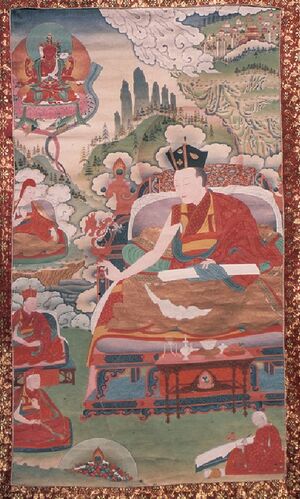Mikyö Dorje on the Transmission of Middle Way Teachings[edit]
The Eighth Karmapa, Mikyö Dorje, is undoubtedly one of the most prolific authors of the Karma Kagyu tradition, having written some twenty-six volumes of works including extensive commentaries on four of the five great sūtra treatises. He wrote commentaries on vinaya, abhidharma, prajñapāramitā and madhyamaka, while the Seventh Karmapa, Chödrak Gyatso, wrote an extensive commentary on pramāṇa.
In his commentary on Candrakīrti's Madhyamakāvatāra, Mikyö Dorje presents a detailed account of the Middle Way and buddha-nature, including a brief account of the transmission of Middle Way teachings. He considers the founding father Nāgārjuna and other luminaries such as Āryadeva, Āryaśūra, and Śāntideva as masters of the primary Middle Way treatises (གཞུང་ཕྱི་མོའི་དབུ་མ་), accepted by all later followers of this school, before the school split into two groups based on the interpretation of the logical and hermeneutic approach through Buddhapālita and Candrakīrti on one side and Bhāvaviveka and his followers on the other. Mikyö Dorje comments that in spite of the differences, both camps present the ultimate understanding of the Middle Way qua ultimate truth.
Elaborating further on the transmission of the Middle Way teachings, he writes that there are transmissions of the actual wisdom of the Middle Way and the transmission of the scholarly study and letter of the Mādhyamika tradition. For the first one, there are three lines of transmission to Tibet. The first one is the lineage of the profound teachings through the Kagyu hierarchs, and this includes two sublineages. One was received via Naropa, Marpa, and Milarepa, while the other was received through Maitrīpa, particularly in the context of his amanasikāra, or nonmentation practice. Despite some criticism from scholars such as Drolungpa and Sakya Paṇḍita, which according to Mikyö Dorje are unjustified, this line has come down to Gampopa, who championed it and spread it vigorously using the term Mahāmudrā.
The second line of transmission was received in Tibet through Atiśa and was passed down through Kadam masters to Gampopa, who was a Kadampa before he became a disciple of Milarepa. This transmission through Atiśa, Mikyö Dorje states, is the same in content or purport as the transmission received via Maitrīpa in the name of Mahāmudrā, but this line adopts a more analytical and apophatic approach to highlight the negational aspect of ultimate reality, while Maitrīpa's approach takes one beyond both apophatic and cataphatic framing to an utter groundlessness. Gampopa is said to have mastered the practice according to the Kadampa approach, but when he met Milarepa and shared his experience, his realization was considered by Milarepa to be incomplete and only capable of overcoming partial problems of grasping and not all forms of grasping to extremes. As such a contemplative practice risks leading to a rebirth in some celestial world, Gampopa is said to have remarked that he risked being born as a celestial being if he did not meet Milarepa.
The third transmission comes through Patsab Lotsāwa Nyima Drakpa, who translated Candrakīrti's Madhyamākavatāra and is known to have introduced the Prāsangika Mādhyamika thought in Tibet. Except for subtle differences in the analytical and contemplative procedure, this line of thought, Mikyö Dorje comments, is similar to the transmission via Atiśa, even in the use of words. Mikyö Dorje also explains that the differences between the three transmissions also depend on the emphasis and effort of the individuals, and it is also possible that adherents of these different transmissions adopt the approaches and techniques from the other transmission lines.
The transmission of the study and interpretation of letters of the Mādhyamakāvatāra in Tibet only begins with Patsab Lotsāwa, from whom it was passed down to Mikyö Dorje himself through some twenty-four masters in the lineage. Mikyö Dorje, then, engages in a long polemical discussion on the difference between the Middle Way transmitted through the sūtra schools and the secret tantric tradition.
Weekly quote[edit]
~

